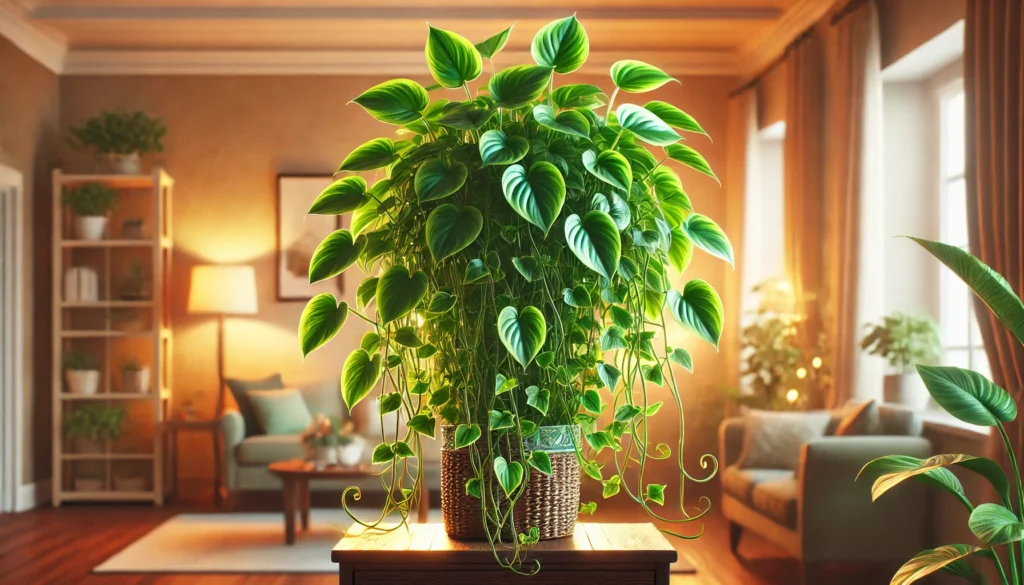
Propagating Pothos Cuttings in Water: A Step-by-Step Guide for Success
If you’re looking for an easy and rewarding way to expand your houseplant collection, propagating pothos cuttings in water is the perfect place to start. Known for its resilience and stunning trailing vines, pothos is one of the most beginner-friendly plants to propagate. The best part? You don’t even need soil to get started! In this guide, we’ll walk you through the simple steps of propagating pothos cuttings in water, ensuring you can grow new plants effortlessly. Whether you’re a seasoned gardener or a total beginner, this method guarantees a lush, thriving pothos plant in no time. Let’s dive in!
Table of Contents
ToggleWhat You Need to Get Started
Getting started with water propagation is simple, but having the right tools and setup is essential for success. Here’s a list of what you’ll need:
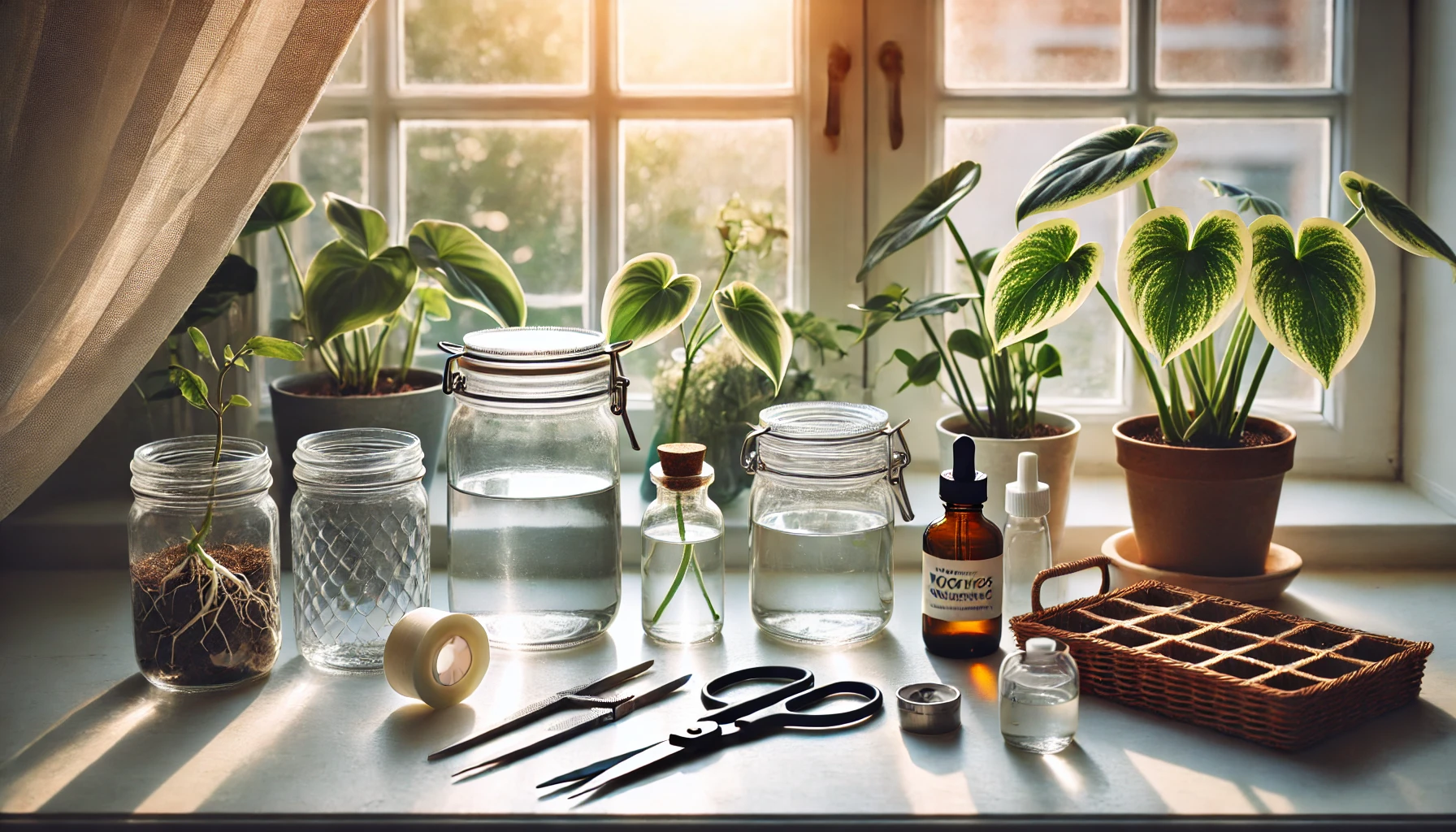
Healthy Plant Cuttings
Choose healthy, disease-free stems to propagate. Look for cuttings with at least one node (where leaves or roots can grow) for the best results.
Clear Containers
Use clear glass jars, vases, or bottles to allow easy monitoring of root growth. Transparent containers also help with proper light exposure for the cuttings.
Clean Water
Start with clean, room-temperature water. Tap water can be used, but avoid using hard water, as it may contain minerals that could harm the plant. Filtered or distilled water is often the best choice.
Sharp Scissors or Shears
Use sharp scissors or shears to make a clean cut. Clean cuts help reduce stress on the plant and prevent infection, ensuring better root development.
Indirect Light Source
Place your container in a location with bright, indirect sunlight. Too much direct sunlight can cause algae buildup in the water or damage the cutting, while too little light will slow growth.
Rooting Hormone (Optional)
While not necessary, rooting hormones can speed up the rooting process and encourage healthy roots. If you choose to use one, dip the cut end of the cutting in the hormone before placing it in water.
With these essentials, you’ll be well on your way to successfully propagating plants in water. Keep it simple, and you’ll enjoy watching your plants thrive!
Choosing the Right Pothos Cutting
Selecting the right cutting is crucial for successful Pothos propagation. Here’s what you need to know:
Select a Healthy Stem
Choose a healthy, mature stem that’s free from pests or disease. Look for a stem with several leaves and at least one node (the small bump or bud where roots will develop). The node is essential for rooting.

Cut Below a Node
Make a clean cut just below a node. The node is where new roots will sprout, so it’s important to ensure it’s intact. Avoid cutting too far from the node as it may not root properly.
Avoid Leggy or Damaged Stems
Do not use leggy, weak, or damaged stems. They may not root well and can lead to a poor propagation success rate. Opt for firm, healthy stems that have enough vitality for growth.
Consider the Length
Aim for a cutting that is about 4-6 inches long. This length provides enough space for roots to develop while maintaining the cutting’s overall strength and stability.
Check for Multiple Nodes
If possible, choose a cutting with multiple nodes along the stem. Multiple nodes mean more opportunities for roots to form, increasing your chances of successful propagation.
By following these guidelines, you’ll increase the likelihood of healthy, thriving Pothos plants after propagation. Choose wisely, and you’re on your way to success!
Step-by-Step Guide to Propagating Pothos Cuttings in Water
Propagating Pothos in water is an easy and rewarding process. Follow these simple steps to grow new Pothos plants from cuttings:
Select a Healthy Cutting
Choose a healthy stem with at least 4-6 inches of growth. Ensure it has a few leaves and, importantly, at least one node (the small bump on the stem where roots will grow).
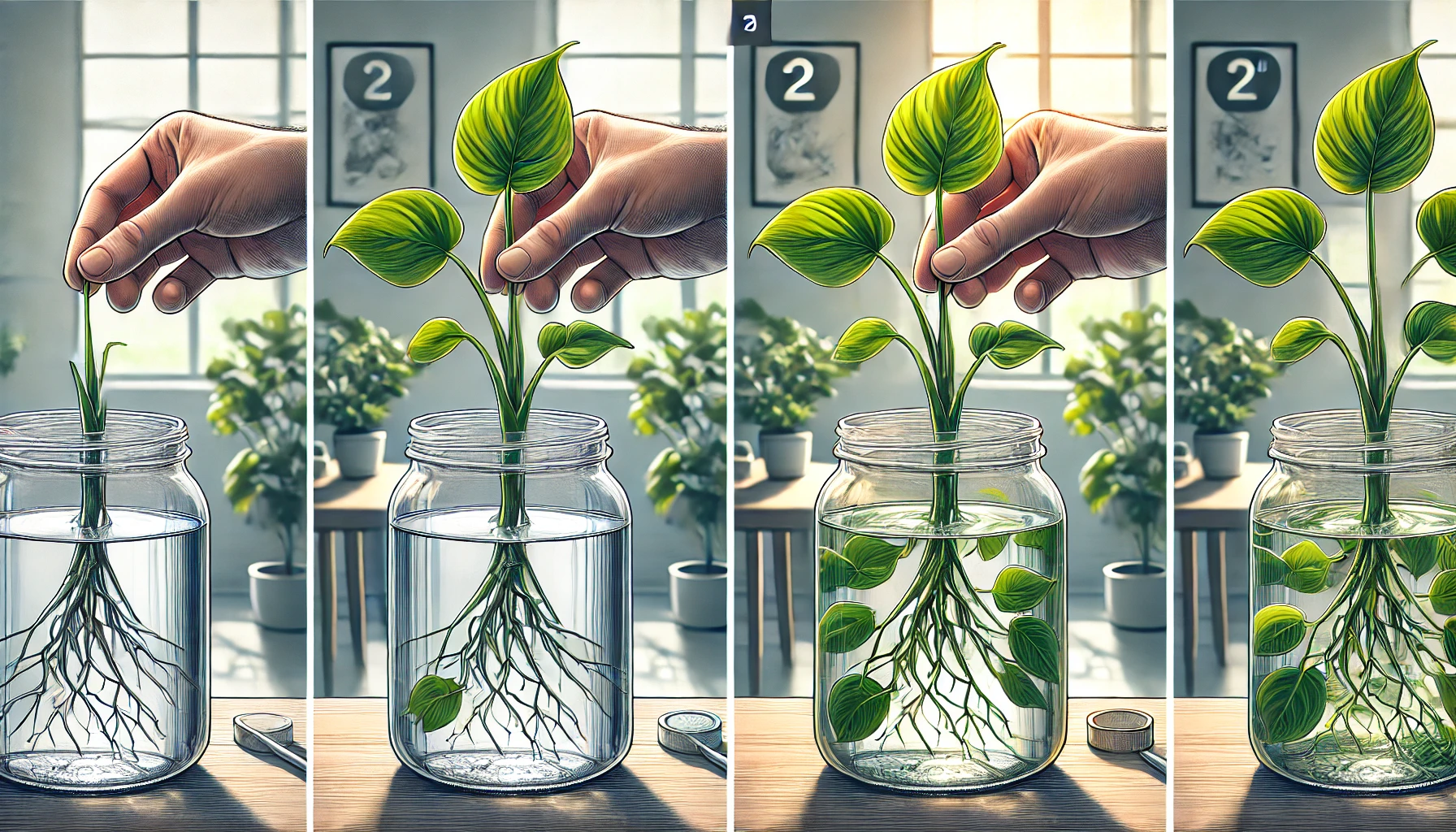
Prepare the Cutting
Use a clean, sharp knife or scissors to make a clean cut just below the node. Remove any leaves that will be submerged in water, as they can rot.
Place in Water
Fill a clear glass or jar with water and place the cutting in it. Submerge the node (where roots will grow) into the water, but ensure the leaves stay above the surface.
Position in Indirect Light
Place the jar in a location with bright, indirect sunlight. Avoid direct sunlight, which can overheat the water and harm the cutting.
Change Water Regularly
To prevent mold and bacteria, change the water every 2-3 days. Keep the water level consistent, making sure the node is always submerged.
Wait for Roots to Grow
After 1-2 weeks, you’ll notice roots beginning to grow from the node. Wait until the roots are about 1-2 inches long before transferring the cutting to soil.
Transfer to Soil (Optional)
Once your cutting has developed healthy roots, transplant it into a well-draining potting mix. Water it regularly and place it in a bright spot to continue growing.
By following these simple steps, you’ll have healthy Pothos cuttings ready to thrive in no time. Happy propagating!
Caring for Pothos Cuttings as They Root
Caring for your pothos cuttings during the rooting process is essential for healthy, thriving plants. Follow these simple but effective tips to ensure your cuttings develop strong roots:
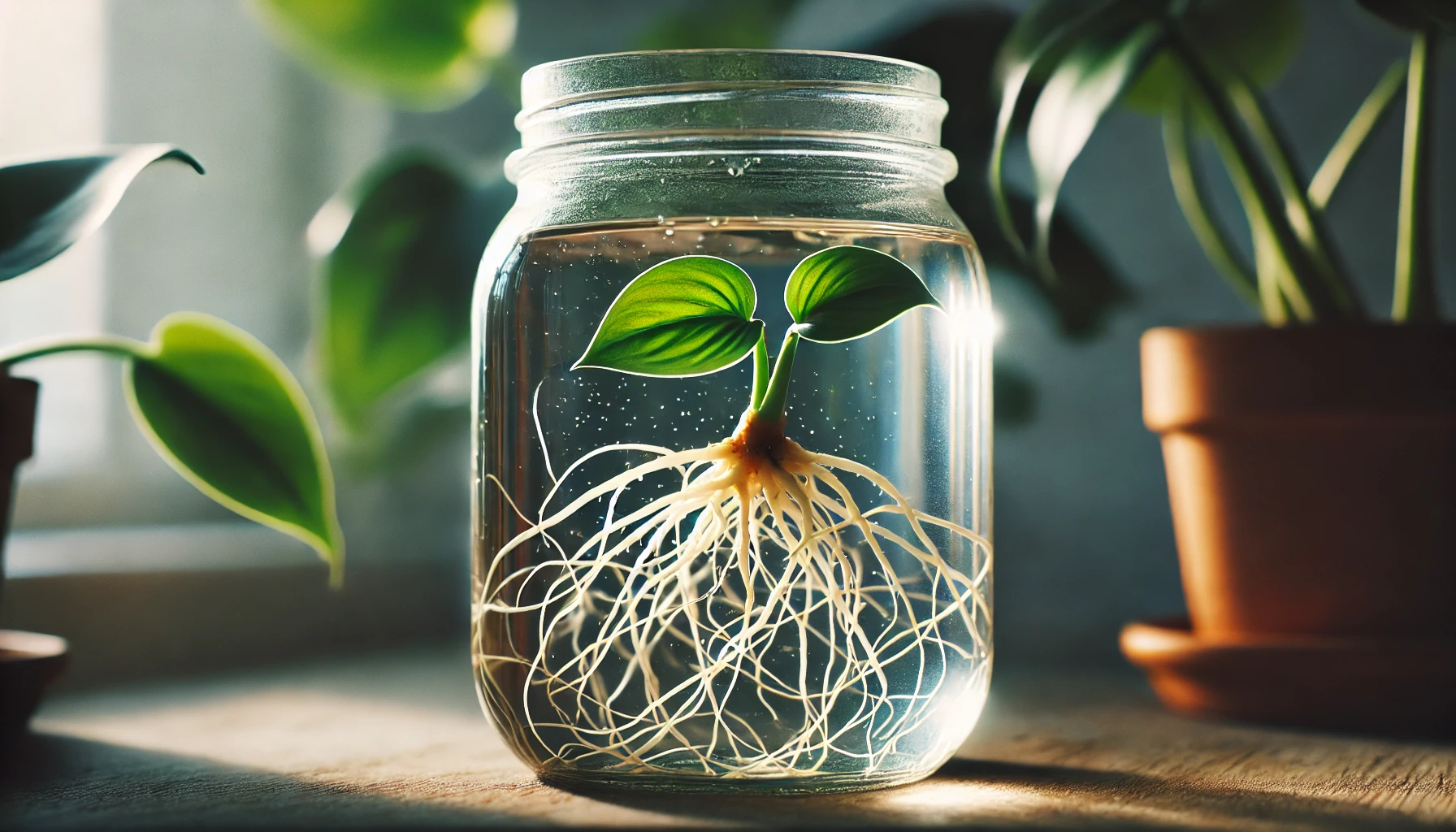
Provide Bright, Indirect Light
Pothos cuttings need plenty of light to encourage root growth, but direct sunlight can scorch them. Place your cuttings in a spot with bright, indirect light, like near a window but out of direct sun. This will help them grow without stressing the plant.
Change the Water Regularly
To keep the water fresh and prevent bacteria or mold growth, change the water every 2-3 days. Clean water encourages strong root development and minimizes the risk of rot.
Ensure Proper Temperature
Pothos thrive in warm environments, ideally between 65-85°F (18-29°C). Keep your cuttings in a room that stays within this range to promote healthy growth. Avoid placing them in cold areas or near drafts, as this can slow down rooting.
Monitor Root Growth
Roots typically start forming within 1-2 weeks. Keep an eye on them to see when they reach about 1-2 inches long. At this point, it’s time to transfer the cuttings into soil for continued growth.
Avoid Overcrowding
If propagating multiple cuttings, make sure each one has enough space to grow. Overcrowding can lead to competition for light and nutrients, resulting in weak or stunted growth. Use separate containers if necessary.
By following these steps, you’ll give your pothos cuttings the best chance to root successfully and grow into lush, healthy plants.
Transplanting Rooted Cuttings
Transplanting rooted cuttings is a crucial step in the propagation process. This is when your cutting moves from water to soil, allowing it to continue growing and thriving. Here are the key steps to ensure a smooth transition:
Choose the Right Time
Wait until the roots are at least 1-2 inches long before transplanting. This ensures the cutting has developed a strong root system that can support its growth in soil.
Prepare the Soil
Use a well-draining potting mix. A mix designed for indoor plants or one with added perlite will help prevent waterlogging and encourage healthy root development. Make sure the container has drainage holes.
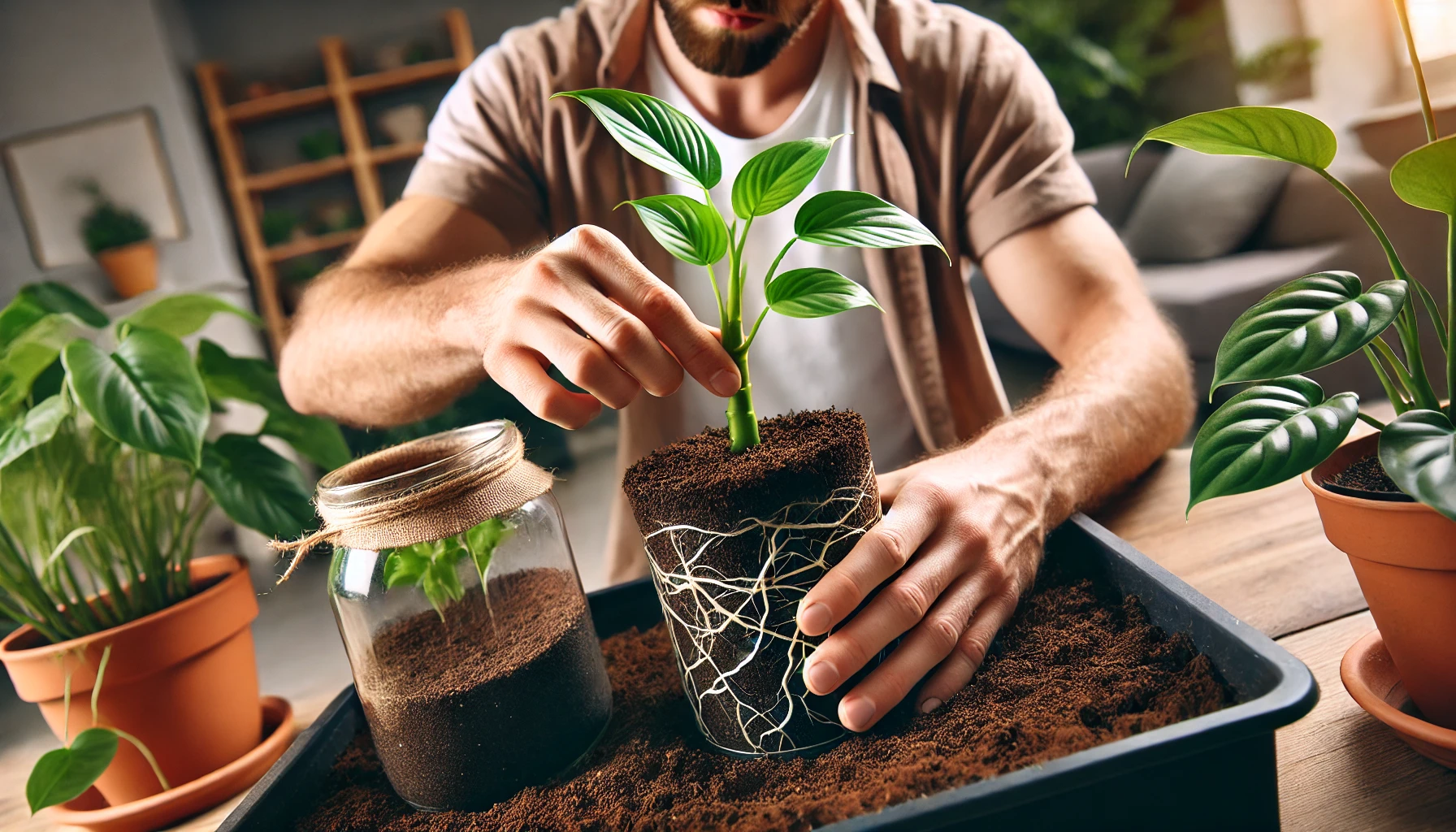
Water Before Transplanting
Before moving your cutting to soil, water it thoroughly to reduce transplant shock. Moist soil helps the roots settle in and minimizes stress on the plant.
Handle with Care
Be gentle when transferring the cutting. Avoid damaging the delicate roots. Create a small hole in the soil with your finger or a stick, and carefully place the cutting into the hole, ensuring the roots are fully covered.
Post-Transplant Care
After transplanting, water the cutting lightly. Keep it in a spot with bright, indirect light to help it acclimate to its new environment. Avoid direct sunlight, which can stress the plant during this adjustment period.
Monitor Growth
Continue to care for the cutting as you would a mature plant. Watch for signs of new growth, which indicates that the cutting is successfully adjusting to its new home.
By following these simple steps, you’ll give your rooted cuttings the best chance to thrive in their new soil environment.
Common Mistakes to Avoid When Propagating Pothos in Water
Propagating pothos in water is a popular and easy way to grow new plants, but there are several common mistakes to avoid to ensure healthy and thriving cuttings. Here’s what you need to watch out for:
Not Using Clean Water
Pothos cuttings thrive in fresh, clean water. Avoid using tap water with high chlorine content, as it can harm the cutting. Opt for distilled or filtered water, and change it every 2-3 days to keep it fresh and prevent mold growth.

Placing Cuttings in Direct Sunlight
While pothos plants love light, direct sunlight can harm the delicate roots during propagation. Place your cuttings in bright, indirect light to encourage healthy growth without stressing the plant.
Submerging Too Much of the Stem
Only submerge the nodes (the areas where roots will grow) in water. If you submerge too much of the stem, it can rot. Be sure the water level covers just the bottom part of the stem where roots will emerge.
Leaving Cuttings in Water for Too Long
While pothos can root in water for a while, leaving them too long can lead to weak roots and poor plant development. Once the roots are about 1-2 inches long, transfer the cutting to soil for better growth.
Using Too Many Cuttings in One Container
Avoid overcrowding your water container. When too many cuttings are packed into one jar, they compete for light and space, reducing the chances of successful rooting. Keep each cutting in its own container for optimal results.
By avoiding these common mistakes, you’ll be on your way to propagating healthy, strong pothos plants that will thrive both in water and when transplanted into soil.
Bonus Tips for Successful Pothos Propagation
When propagating Pothos, a little extra care can go a long way. Here are some expert tips to ensure your Pothos cuttings thrive:
Use Clean Tools: Always use sharp, clean scissors or pruning shears when taking cuttings. This helps prevent infection and ensures a clean cut, promoting healthy growth.

Choose the Right Stem: Select a healthy stem with at least two nodes (the small bumps where leaves grow). The more nodes, the better your chances of successful rooting.
Watering Tips: Keep the water level consistent but not too high. The nodes should be submerged, but leaves should stay dry to prevent rot.
Change the Water Regularly: If rooting in water, change it every 2-3 days to avoid bacteria buildup. Fresh water will encourage stronger roots.
Be Patient with Light: Keep your cuttings in bright, indirect light. Too much direct sunlight can scorch the leaves, while too little light will slow down the rooting process.
Add Rooting Hormone: While not essential, applying a rooting hormone can boost root development, especially for slower-to-root cuttings.
Consider Humidity: Pothos cuttings thrive in higher humidity. Placing a clear plastic bag over the cutting (without touching it) can create a mini greenhouse effect, helping roots develop faster.
By following these tips, you’ll be on your way to a healthy, thriving Pothos plant collection. Happy propagating!
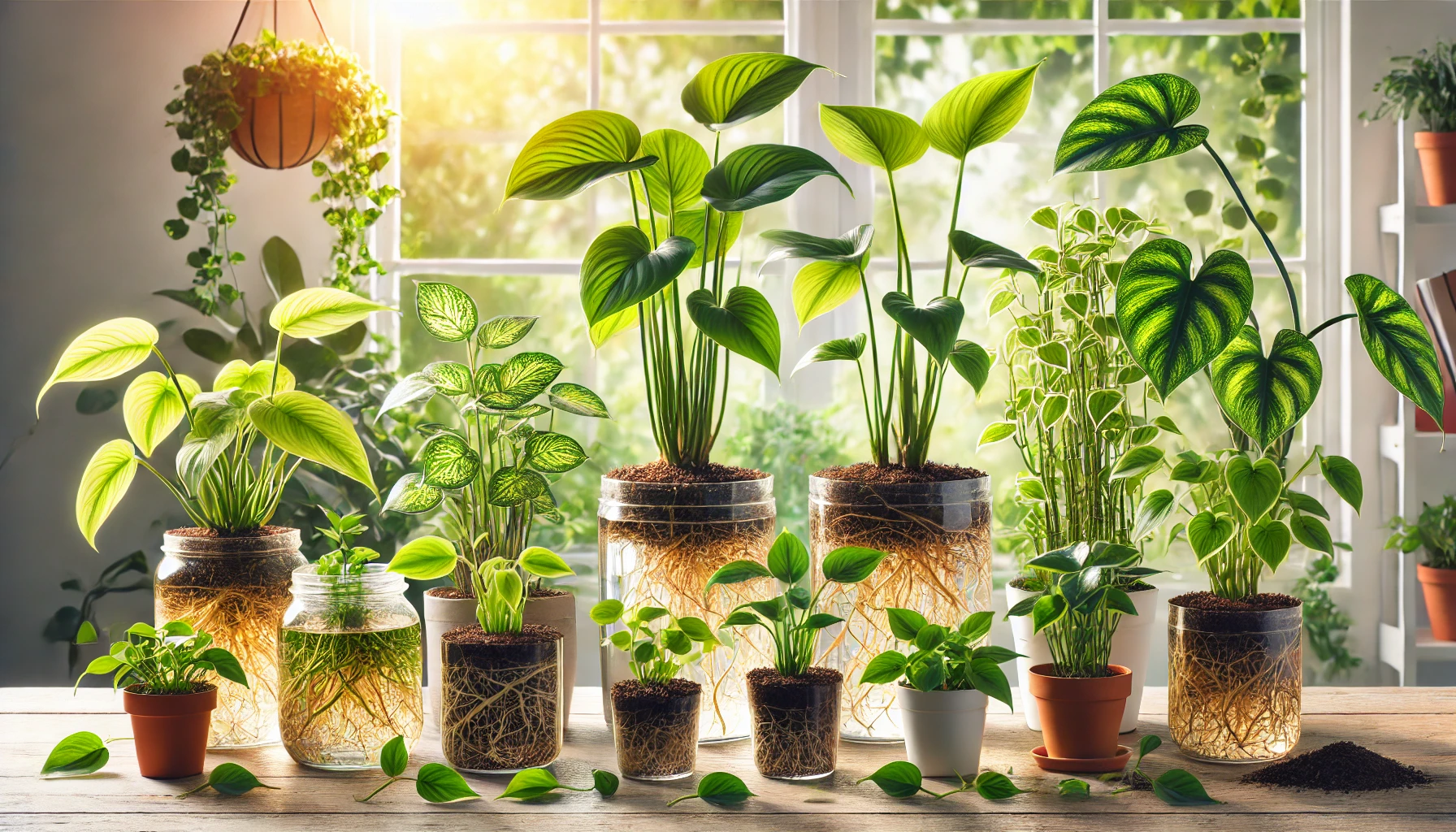
Propagating pothos cuttings in water is a simple, enjoyable, and highly rewarding process that allows you to expand your plant collection with ease. By following the steps outlined in this guide, you can successfully grow new pothos plants from just a small cutting. Remember, patience is key—give your cuttings the time they need to develop strong roots, and you’ll soon have healthy, thriving plants to enjoy or share with friends and family. Whether you’re a seasoned plant parent or a beginner, propagating pothos in water is a fun and effective way to connect with nature and watch your plants grow. Happy propagating!
Frequently Asked Questions(FAQ)
How long does it take for pothos cuttings to root in water?
Pothos cuttings typically take about 1 to 3 weeks to develop roots in water, depending on environmental factors like temperature and light. Warmer temperatures and indirect sunlight will encourage faster root growth.
Can you propagate pothos cuttings in water indefinitely?
While pothos can grow in water for a period, it’s recommended to transplant the rooted cuttings into soil once the roots are well-developed. This provides the plant with more nutrients and promotes long-term health.
What should I do if my pothos cutting isn’t rooting in water?
If your cutting isn’t rooting, check for a few key things: ensure the node is fully submerged (but not the leaves), change the water regularly to keep it clean, and make sure the cutting is receiving enough indirect sunlight. You may also want to try rooting hormone to encourage faster root growth.
Can I propagate multiple pothos cuttings in the same water jar?
Yes, you can propagate multiple pothos cuttings in the same jar, but make sure they don’t crowd each other. Give each cutting enough space to grow and ensure the water level is sufficient for all the nodes to stay submerged.
Why are the leaves of my pothos cutting turning yellow while propagating in water?
Yellowing leaves could be a sign of overexposure to direct sunlight, underwatering, or poor water quality. Make sure to place the cutting in a bright spot with indirect sunlight and change the water every few days to keep it fresh.
Can I propagate pothos cuttings in just any container?
You can use any clean container, but clear glass jars or vases are ideal because they allow you to monitor the root development. Ensure the container is large enough to comfortably hold the cutting without being too cramped.
How do I know when my pothos cutting is ready to be transplanted into soil?
Your pothos cutting is ready to be transplanted when the roots are about 2-4 inches long. At this stage, the cutting is strong enough to survive and thrive in soil. Gently transfer it to a pot with well-draining soil for optimal growth.
Can I use a rooting hormone when propagating pothos cuttings in water?
While pothos will root just fine in water without rooting hormone, using it can speed up the rooting process and ensure more successful results. Simply dip the end of the cutting in rooting hormone before placing it in water.
